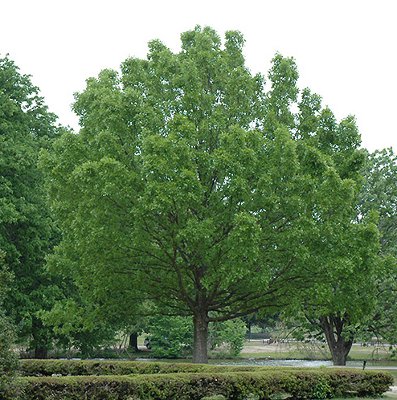Overcup Oak Tree
Category: Deciduous Trees

Facts about Overcup Oak Tree "Scientific name for Overcup Oak Tree is Quecus lyrata". The Overcup oak tree, Quercus lyrata, is a medium-sized deciduous oak which is highly tolerant to floods and is native to Southeastern United States where it grows on areas around the swamps and poorly drained plains. The Overcup Oak Tree can grow to a maximum height of about 65 feet (20 meters) tall with a trunk of approximately 31 inches (80 cm) sometimes but rarely 55 inches (140 cm).
The Overcup Oak Tree’s leaves can vigorously grow to a length of about 4 to 6 1/4 inches (10 to 16 cm) long and 2 to 4 inches(5 to 10 cm) wide. The leaves can be lyre-shaped, deeply lobed and dark green in color with a paler color of the same underneath and with hairy tufts.
Both the Male and the female Overcup Oak flowers, catkins, of the monoecious Overcup Oak Tree appear together with the leaves or during the leaves development periods around the months of April to May. The flowers are characterized with the staminate flowers which are developed with naked catkins while the pistillate flowers constitute of spikes.
A Full grown Overcup Oak Tree can absorb as much as 48 pounds (21.77 kg) of carbon dioxide a year. The same Overcup Oak Tree could also produce enough oxygen in a day for two people. In a single day, a large Overcup Oak Tree can drink up to 100 gallons (378.5 liter) of water from the ground and discharge it into the air.
You can tell a Overcup Oak Trees age by the number of growth rings. Growth rings size shows what kind of conditions accrued that year, the temperature and if it was a dry or wet year.
Bark of the Overcup Oak Tree protects it from the elements and is made up of dead cells.
The Overcup Oak Tree flowers are usually pollinated and take around six to seven months to produce fruits, acorns. However, it can take up to thirty years before the fruits are first developed. Once the acorns are develop, they can grow up to 1/2 to 1 inch (12 to 25 mm) long with a spherical, flattened shape which is wider at the base and fully covered with a scaly cup. These fruits usually take one year in order to mature and ripen in late September or early October.
The Overcup Oak Tree can survive the best in poorly-drained, alluvial to clay soils which can be found in river flood plains. It has established in the low lying salty and clay flats of basins and terraces of bigger streams. Overcup Oak Tree can also grow naturally on the edges of sloughs, bayous and swamps.
Overcup Oak Tree roots usually grow two to three times the width of the tree branches. The ideal time to fertilize your Overcup Oak Tree is in late fall or early spring. If you want to transplant a Overcup Oak Tree do it in fall, this is ideal for most trees.
Overcup Oak Tree leaves are made up of many colored pigments, green chlorophyll hides the colors during the growing season of spring and summer. As days get shorter and cooler temperatures come in the fall, it cause the chlorophyll to break down and than the other color pigments can be seen.
Overcup Oak Tree growth is referred to as Meristem (The undifferentiated embryonic plant tissue from which new cells are created, as that at the tip of a root or stem). This tissue can be found at the tips of shoots and leaves. Inside the stem growth in thickness occurs at the vascular cambium.
Overcup Oak Trees make their own food from sunlight, carbon dioxide, water, and nutrients from the soil.
The Overcup Oak Tree produces logs which can be used for tight cooperage and lumber. However, it cannot be used frequently for factory lumber as the logs can warp and crack during seasoning. It can also be planted for ornamental purposes. The acorns are edible to animals and can be eaten by the wild. This massive Overcup Oak Tree can also act as habitat for some wild animals.

 Back To Category Deciduous Trees
Back To Category Deciduous Trees